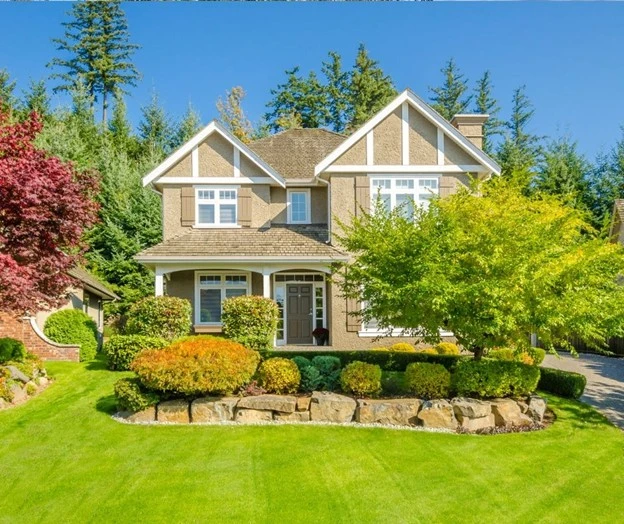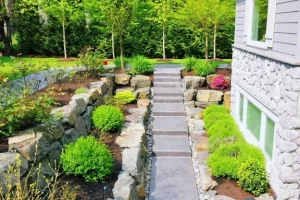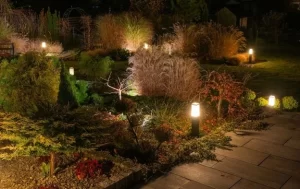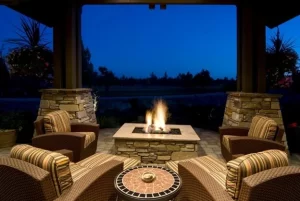As autumn’s golden hues descend and the days grow shorter, transforming your front yard into a stunning, low-maintenance sanctuary is an ideal way to enjoy the season’s charm. Landscaping with rocks for fall offers the perfect blend of beauty, durability, and ease, providing natural textures and structures that remain attractive even as plants go dormant.
This article shares expert landscaping design strategies, inventive landscaping ideas, and practical tips specifically for landscaping for front of house spaces using rocks—helping homeowners achieve stunning curb appeal with minimal upkeep before winter arrives.

Why Choose Landscaping with Rocks for Fall?
Landscaping with rocks excels for fall because it requires little maintenance and complements the rich colors of autumn foliage. Unlike flower beds that may need regular watering and deadheading, rocks provide year-round structure and interest. They reduce reliance on mulch, which can degrade over winter, and prevent soil erosion during rainy fall weather.
Rocks also reflect the warm fall tones of changing leaves and can provide a striking contrast to seasonal plants like chrysanthemums, ornamental grasses, and fall-colored shrubs. This makes landscaping with rocks a smart investment in beauty and sustainability for the front of the house.
1. Use River Rocks for Clean Bed Edging
River rocks’ smooth, rounded shapes and varied colors make excellent borders around flower beds or trees. In fall, they highlight yellow, orange, and red leaves and add an organized look to garden beds while suppressing weeds and protecting soil from heavy rains.
Lining pathways with smaller river rocks creates inviting walkways that blend beautifully with the natural landscape of Frederick County’s autumn season. This simple approach enhances landscaping with rocks in your front yard.
2. Design Gravel Pathways with Fall-Color Plants
Gravel pathways using decomposed granite or pea gravel provide a rustic feel while promoting good drainage. Coupling these paths with plantings of fall perennials, like black-eyed Susans or New England asters, enhances the seasonal appeal.
Gravel is low-maintenance, doesn’t compact or erode easily, and can be refreshed simply by adding more material as needed. Incorporating gravel pathways is a smart feature of landscaping with rocks.
3. Create Drought-Tolerant Rock Gardens
With drought concerns prevalent in many areas, rock gardens planted with succulents, sedum, and ornamental grasses offer a colorful, low-water alternative that thrives into fall. Rocks retain heat, protecting roots through chilly nights and adding to the garden’s textural interest.
Integrate fall-appearing grasses with bronze, red, or gold foliage to complement the stones’ neutral tones with seasonal vibrancy. Drought-tolerant gardens are an important part of successful landscaping with rocks.
4. Build Retaining Walls with Natural Stone
Natural stone retaining walls help manage sloped yards by preventing soil erosion while providing a rustic backdrop for fall plantings. Stacked stone walls create tiered garden beds perfect for hardy shrubs that maintain color into late autumn.
A layered landscape with varying heights adds dimension and increases curb appeal during the fall and winter months.
5. Add Large Boulders as Focal Points
Incorporate impressive boulders as anchors in your front yard landscaping to draw the eye and break up flat spaces. Surround boulders with moss, low-growing ground covers, or seasonal mums to integrate them into your fall design naturally. They can also serve as informal seating areas or play spots for families. These large boulders create striking focal points in landscaping with rocks.
6. Replace Mulch with Decorative Rock
Autumn smoke landscaping rocks and other colored stone mulches serve as lasting alternatives to organic mulches. They resist decomposition through fall leaves and winter weather and reflect light to brighten shaded areas.
Decorative rock mulch reduces maintenance by deterring weeds and stabilizing soil temperature, making it ideal for fall landscaping preparation.
7. Incorporate Rock Water Features
Small rock fountains or ponds framed with natural stone add the soothing sound of water to your fall landscape. Rock water features bring life and motion to gardens even as flowers fade, extending outdoor enjoyment.
Lighting water features with warm LED landscape lights enhances their tranquil beauty during the longer autumn evenings.
8. Outline Driveway and Path Edges with Pebbles
Using pebbles to border driveways and walkways defines edges neatly while complementing paving materials. This creates a clean, polished look that withstands leaf litter and ground moisture in fall.
Pebble borders also help with drainage and can be updated easily without heavy labor.
9. Blend Rocks with Autumn Blooming Plants
Pair rocks with chrysanthemums, pansies, sedum, ornamental cabbage, and grasses like fountain grass to highlight fall colors and textures. This mixture creates visual contrast and supports a wildlife-friendly garden, providing cover and food sources for local birds and pollinators.
10. Enhance Landscaping Circles or Beds with Stone Borders
Circular beds edged with tightly stacked stone or flagstone create focal shapes perfect for seasonal plant displays or small trees. The crisp lines contrast beautifully with softened fall foliage while keeping beds protected from foot traffic and erosion. Stone borders are another element that completes landscaping with rocks beautifully.
Benefits of Low-Maintenance Rock Landscaping for Fall
- Saves time and water compared to traditional plant-heavy beds. Landscaping with rocks helps reduce upkeep and conserve water.
- Provides all-season interest and structure even after annuals fade.
- Resists weathering from rain, wind, and frost common in fall and winter.
- Enhances the natural look of your property while sustaining soil health.
- Safeguards against erosion on sloped or uneven ground.
Practical Tips for Successful Fall Rock Landscaping
- Select stones that complement your home’s architecture and natural surroundings.
- Prep soil to ensure proper drainage before placing rocks.
- Use landscape fabric under gravel or mulch rocks to control weeds.
- Combine different sizes and colors of rock for natural appeal and dimension. This approach is essential in effective landscaping with rocks.
- Add subtle outdoor lighting to highlight rock features and pathways during dark fall evenings.
Frequently Asked Questions About Landscaping with Rocks for Fall
1. How do I maintain my rock landscaping through the fall and winter months?
Routine maintenance involves removing fallen leaves and debris, hand-pulling any weeds that emerge, and periodically spraying rocks with a garden hose to clear dust and dirt. Inspect your rocks for any settling or erosion, especially after heavy rains, and add fresh rock as needed to maintain coverage. Pressure washing rocks annually can renew their appearance and prolong their life.
2. Are rocks a good choice for low-maintenance fall landscaping?
Yes, rocks are excellent for low-maintenance landscaping. Unlike organic mulches, they do not decompose or need frequent replacement. Rocks help control weeds and reduce watering needs by stabilizing soil temperature and preventing erosion, making them ideal for fall landscaping transitioning into winter. This is why landscaping with rocks is a smart, long-lasting choice.
3. Can I combine rocks with plants in my front yard fall landscape design?
Absolutely. Combining rocks with drought- and cold-tolerant plants like ornamental grasses, sedum, black-eyed Susans, and chrysanthemums creates natural texture and year-round interest. Landscaping with rocks provides a stable base and enhances visual appeal when paired with seasonal plants.
4. How do I prevent rocks from sinking or shifting over time?
To prevent sinking or uneven surfaces, install rocks over a well-prepared base such as compacted gravel or landscaping fabric. Large boulders should be placed on a crushed stone bed for stability. Regular raking and periodic replenishment of smaller rocks or gravel also help maintain an even landscape surface.
5. What are the benefits of using decorative rock instead of mulch for fall landscaping?
Decorative rock lasts much longer than organic mulch, resisting decomposition and reducing the frequency of replacement. It improves drainage, suppresses weed growth, and better withstands winter weather. Additionally, decorative stone reflects natural fall colors and provides clean, crisp edges to flower beds and pathways, making it a smart, attractive choice for landscaping design.
About Hawkins Landscaping in Frederick County
Hawkins Landscaping Inc. is a premier provider of landscaping design services in Frederick County, specializing in sustainable and creative landscaping with rocks solutions ideal for fall and year-round beauty. Their expert team understands local soil and climate conditions to customize front of house landscaping and hardscaping projects that maximize curb appeal with minimal maintenance. They offer flexible financing options, ensuring properties of all sizes and budgets benefit from professional landscaping improvements, from elegant rock gardens to functional retaining walls and more.
Embrace Stunning, Low-Maintenance Fall Landscaping Today
Ready to capture the vibrant spirit of fall in your front yard without the hassle of high maintenance? Let professional landscapers help you design and install thoughtful, elegant landscaping with rocks that shines through autumn and beyond.
Contact Hawkins Landscaping Inc. today at (301) 898-3615 to schedule a consultation. Discover how flexible financing and expert landscaping ideas can turn your outdoor spaces into a welcoming retreat that boosts curb appeal and saves you time. Illuminate your home’s exterior with beautiful, low-upkeep landscaping design perfect for Frederick County’s seasons. Start your fall landscaping project now!




